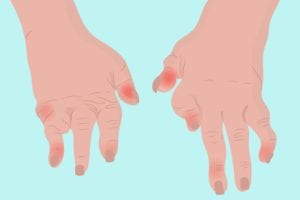Arthritis mutilans is a severe, rare, and destructive type of arthritis that is most commonly seen in people with psoriatic arthritis. (Arthritis mutilans may also occur in rheumatoid arthritis, but that is rare.) The condition damages and destroys joints and bones. Normally, bone cells break down and rebuild. But when you have arthritis mutilans, the bones do not rebuild. Instead, the soft tissues of the bones collapse.
Arthritis mutilans can impact the fingers, hands, wrists, and feet. The condition is sometimes called “opera glass hand” or “telescoping finger.” Since the joints and bones are so damaged, when you pull on the involved fingers, they can look like the opening of opera glasses. Telescoping fingers refers to when the bones dissolve and the soft tissues can’t hold the fingers up. So the fingers end up looking like a telescope.
Causes of Arthritis Mutilans: How You Know You Have It
It’s unknown what causes some people to be more susceptible to develop arthritis mutilans.
People with psoriatic arthritis are at the highest risk for developing this form of arthritis. However, most people with psoriatic arthritis will not get arthritis mutilans.
Even if someone has psoriatic arthritis, their risk of arthritis mutilans is low if they take medication and avoid disease progression. Thanks to more effective treatments for psoriatic arthritis, arthritis mutilans is rare.
It is most likely to develop when a person with psoriatic arthritis hasn’t gotten treatment for many years, according to a study in the journal the Annals of Long-Term Care. Arthritis mutilans is typically seen in people who haven’t been treated or whose condition is unresponsive to treatment, says Paloma Alejandro, MD, a rheumatologist at MedStar Washington Hospital Center in Washington, DC.
Arthritis mutilans affects less than 5 percent of patients who have psoriatic arthritis, says Dr. Alejandro. “Why patients get this isn’t really known. It’s a rare manifestation of psoriatic arthritis.”
Symptoms of Arthritis Mutilans
When you develop arthritis mutilans, you experience severe inflammation. That leads to the wearing down of joints and bone tissues in the feet and hands. It’s difficult to bend, move, or straighten the affected joints. The affected joints will shorten over time, which also causes the development of loose skin in the affected areas. “Fingers are very thin by the nail and then thick and fat toward the hand,” says Dr. Alejandro. “The middle joint of the finger has been completely destroyed.”
Another result of arthritis mutilans is that bones will fuse together, which is known as ankyloses. That causes stiffness and immobility of the joint.
Other symptoms of arthritis mutilans include stretched, shiny, and wrinkled finger skin. You may have stiffness and won’t be able to completely make a fist or move your fingers well, says Dr. Alejandro.
Arthritis mutilans can impede daily activities like dressing and cooking. A study in the Scandinavian Journal of Rheumatology of 67 patients with arthritis mutilans found that 42 percent had retired early or were on sick leave. Twenty-one percent of patients reported little or no ability to perform self-care or everyday tasks.
How Arthritis Mutilans Is Diagnosed
Arthritis mutilans is diagnosed first by confirming that you have arthritis and what kind of arthritis you have. Your rheumatologist will check your joints for signs of swelling or tenderness. Your rheumatologist will do bloodwork to help understand what kind of arthritis you have. “History and physical exam are the key to a diagnosis,” says Dr. Alejandro.
X-rays are then used to help physicians see exactly what’s happening with the joints, and whether your joint damage could be arthritis mutilans.
How Arthritis Mutilans Is Treated
Since arthritis mutilans is progressive, the sooner it is diagnosed, the better the chance of being able to slow down future joint damage. Early treatment of arthritis mutilans can help prevent bone loss. While bone tissue can’t be restored fully, treating arthritis mutilans can help slow bone destruction. You’ll most likely be able to keep your fingers or toes working.
Medication
Treatments most often include disease-modifying antirheumatic drugs (DMARDs) such as methotrexate, biologics (a class of targeted drugs that help stop inflammation), or both. “These medicines reduce arthritis-related inflammation and, as a result, protect joints from these destructive changes,” says Ted Mikuls, MD, Umbach Professor of Rheumatology, Internal Medicine in the division of rheumatology at the University of Nebraska Medical Center in Omaha.
Case in point: A paper published in the Journal of Drugs in Dermatology described three patients with psoriatic arthritis mutilans who were followed up for two years. They were treated with etanercept (Enbrel), a TNF inhibitor biologic that is used to treat psoriatic arthritis and psoriasis. The patients had significant joint and skin improvement with this therapy, though the treatment cannot reverse damage and deformity from years prior to treatment.
Medications are used for the long term. “Up to 60 percent of patients tend to relapse as soon as they stop the medication,” says Dr. Alejandro. “They need it or they will have flares.”
Hand therapy
Hand physical therapy can also help delay progression of arthritis mutilans and reduce severe joint damage. “It’s like occupational therapy,” says Dr. Alejandro. “It strengthens muscles around the joints so they don’t become weak.”
Surgery
Surgery (such as joint fusion) can be used to relieve symptoms and improve function with arthritis mutilans. “Surgery can be used if the amount of pain is affecting daily living,” says Dr. Alejandro. “But it’s a last resort.”
Keep Reading
Subscribe to CreakyJoints
Get the latest arthritis news in your inbox. Sign up for CreakyJoints and hear about the latest research updates and medical news that could affect you.






